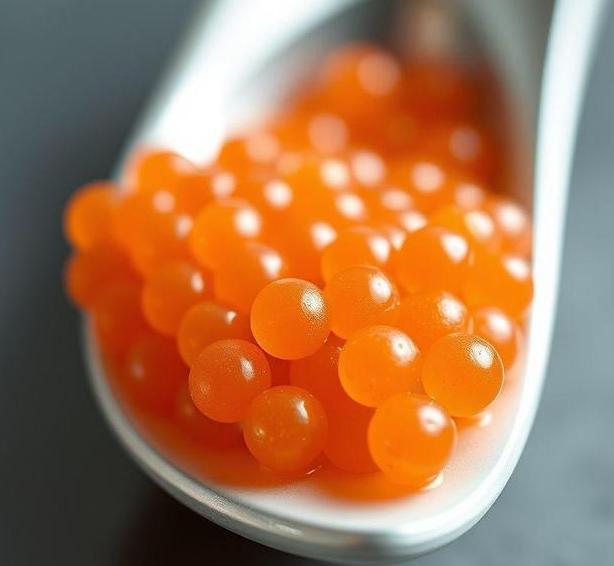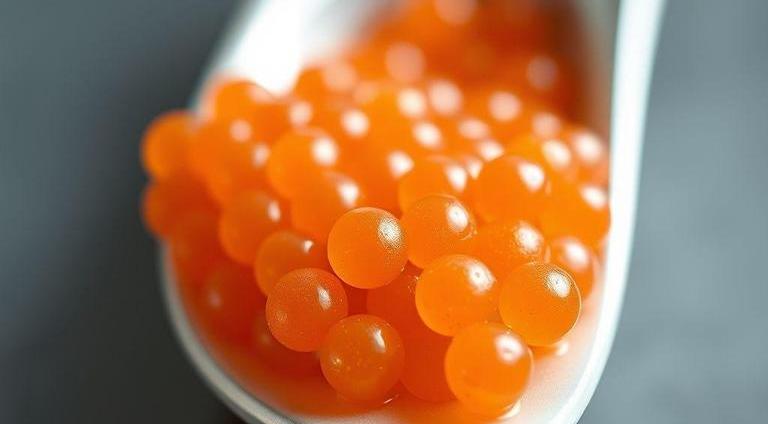Can Salmon Roe Go Bad : What You MUST Know
Salmon roe, those glistening orange pearls often seen as a luxurious delicacy in sushi or as a garnish for other dishes, has been a staple in various culinary traditions for centuries. Whether you’ve had it in fine dining restaurants or at a casual sushi bar, salmon roe, also known as ikura, is a flavorful and rich treat that packs a punch with its slightly salty, briny flavor and delicate texture. But like many perishable foods, it raises a very important question for the home chef or the roe enthusiast: Can salmon roe go bad?
It’s easy to think of salmon roe as something that might last forever, especially with its pristine, jewel-like appearance. However, just like any other seafood product, it has a limited shelf life and needs proper care to maintain its quality and safety. In this article, we’ll dive into all the details surrounding salmon roe, how to tell if it’s gone bad, how long it lasts, and the best ways to store it so you can enjoy it at its freshest.
Can Salmon Roe Go Bad?
Absolutely. Like any raw fish product or perishable food, salmon roe can go bad. Its rich, delicate composition makes it highly susceptible to spoilage, especially if not handled properly. Salmon roe is essentially the eggs of salmon, and while it may seem durable in its firm, bright form, it is still biologically living tissue. This means it can be affected by bacteria, temperature changes, and other environmental factors that can cause it to deteriorate.
Roe, when processed and packed correctly, can maintain its quality for a while, but it will eventually degrade, losing both its flavor and texture. Additionally, because it’s often packed in brine or salt, there’s a certain degree of preservation, but that doesn’t make it impervious to spoilage.
Shelf Life For Salmon Roe

The shelf life of salmon roe depends on several factors, including the method of preservation, the temperature at which it’s stored, and whether it’s opened or unopened.
Unopened Salmon Roe
- Refrigerated: When sealed in its original container and stored in the fridge, unopened salmon roe can last for up to 2-3 weeks. Always check the “use by” date or expiration date on the package as well, as some products may come with preservatives that extend this window slightly.
- Frozen: If you’re not planning to use it right away, freezing unopened salmon roe is an option, extending its shelf life to 6-12 months. However, freezing may affect the texture slightly, so it’s best used in recipes where the roe will be eaten in its cooked form.
Opened Salmon Roe
- Refrigerated: Once the container has been opened, salmon roe should be consumed within 3-5 days. The exposure to air and the breakdown of salt preservation can speed up spoilage. Make sure to keep the roe tightly sealed in an airtight container for the best quality.
- Frozen: If you’ve opened the package but still want to extend its shelf life, you can freeze the roe, though it’s best consumed within 1-2 months for optimal taste and texture.
In general, while salmon roe has a relatively short shelf life, it’s highly valued for its fresh, vibrant flavor. So, it’s always best to consume it as quickly as possible to get the most out of it.
Common Signs Of Spoilage
Knowing when salmon roe has gone bad is crucial, especially since it’s such a delicate ingredient. Spoiled roe can be a health risk, so here are the key signs to look out for:
Off Or Sour Smell
- Fresh salmon roe should have a clean, briny scent, reminiscent of the sea. If it starts to emit a sour, rancid, or ’fishy’ odor, it’s a clear indication that spoilage has begun.
Discoloration
- Salmon roe is known for its bright orange color, sometimes ranging to red or golden. If you notice any unusual darkening or mottled patches on the roe, it may be a sign that it’s gone bad. The color should remain consistent and vibrant, so any fading or dullness is a red flag.
Mold Or Slimy Texture
- Mold growth can be a concern with spoiled roe, especially if it has been exposed to moisture and air for too long. A slimy, greasy texture is another indication that bacteria are breaking down the roe, so discard it immediately.
Unpleasant Taste
- If you’ve noticed any of the above signs and decide to taste the roe, a bitter, sour, or off taste means the roe has passed its prime. Fresh salmon roe has a delicate, salty taste with a smooth texture, so anything that deviates from this suggests spoilage.
How To Store Salmon Roe?

Proper storage is crucial for extending the shelf life of salmon roe and maintaining its quality. Follow these guidelines to ensure your roe stays fresh for as long as possible:
Keep It Cold
- Refrigeration is key: Salmon roe should always be stored in the fridge at or below 40°F (4°C). When in doubt, a temperature-controlled, dedicated fridge (like a wine fridge) can help ensure the roe doesn’t get exposed to frequent temperature fluctuations, which can lead to spoilage.
Airtight Storage
- Once opened, place the salmon roe in an airtight container to minimize exposure to air and bacteria. Avoid storing it in the original packaging, especially if it’s not resealable. An airtight glass jar works great, or you can transfer it to a plastic container that seals tightly.
Freeze For Long-Term Storage
- If you don’t plan on eating the roe within a few days, freezing is an effective option. Transfer the roe to a freezer-safe container or a vacuum-sealed bag to preserve its quality. Remember to thaw it in the fridge overnight instead of at room temperature to avoid bacteria growth.
Avoid Cross-Contamination
- Use clean utensils when serving the roe, and avoid touching the roe with bare hands. This reduces the risk of introducing bacteria, which can accelerate spoilage.
Expert Tips
If you’re looking to make the most of your salmon roe and extend its shelf life, here are a few expert tips that can make a significant difference:
- Use Salt or Brine for Preservation: While fresh salmon roe is delicious, storing it in a salt brine can help it last much longer. Many professional chefs recommend lightly salting the roe and storing it in a sealed container for improved preservation.
- Don’t Mix with Acidity Right Away: If you plan to use salmon roe in a recipe that involves vinegar or citrus (like a marinade), do so only shortly before serving. The acid can cause the roe to break down faster and lose its texture.
- Avoid Freezing Repeatedly: Freezing salmon roe more than once can degrade its texture. If you’ve already thawed it, try to consume it within a short time frame.
- Consider Caviar: If you’re a roe enthusiast, consider investing in premium caviar, which is typically processed and packed in a way that extends its shelf life considerably compared to standard salmon roe.
FAQs
Can Salmon Roe Go Bad If Left Out At Room Temperature?
Yes, salmon roe can go bad if left out at room temperature for an extended period. The high protein and fat content of roe makes it a prime environment for bacterial growth. It should be kept refrigerated or frozen to prevent spoilage.
How Long Does Salmon Roe Last In The Fridge?
Salmon roe typically lasts about 3 to 5 days in the fridge if stored properly in an airtight container. Always check for any signs of discoloration, odor, or changes in texture before consuming.
Can Salmon Roe Go Bad After Being Opened?
Yes, once opened, salmon roe is more susceptible to bacterial contamination. It should be consumed within a few days (usually 2-3 days) or stored in the freezer for longer preservation.
What Are The Signs That Salmon Roe Has Gone Bad?
Signs that salmon roe has gone bad include an off or sour odor, changes in color (such as darkening or cloudiness), slimy or mushy texture, or visible mold growth. If any of these signs are present, the roe should be discarded.
Can Salmon Roe Be Frozen To Extend Its Shelf Life?
Yes, salmon roe can be frozen to extend its shelf life. If stored in an airtight container or vacuum-sealed bag, it can last up to 6 months in the freezer. However, freezing may alter the texture slightly upon thawing.
How Can I Tell If Salmon Roe Is Still Fresh When Purchasing?
When purchasing salmon roe, look for bright, translucent eggs with no discoloration or cloudy liquid. Fresh roe should not have a strong odor. If it has a pungent or sour smell, it may already be spoiled.
Can Salmon Roe Go Bad If It’s Kept In Brine?
Salmon roe stored in brine has a longer shelf life due to the preservation properties of salt. However, it can still go bad if not refrigerated properly or if the brine becomes contaminated. Always check for signs of spoilage before consumption.
Is It Safe To Eat Expired Salmon Roe?
It is not recommended to eat expired salmon roe as it may pose a health risk. The roe can become a breeding ground for bacteria like Salmonella or Listeria, which can lead to foodborne illnesses.
Does Salmon Roe Spoil Faster Than Other Fish Roe?
Salmon roe can spoil relatively quickly compared to some other fish roe, like caviar, due to its higher fat content and the fact that it is often sold fresh rather than processed. Proper storage is key to ensuring its longevity.
What Temperature Should Salmon Roe Be Stored At To Prevent Spoilage?
Salmon roe should be stored at temperatures below 40°F (4°C) in the refrigerator. Freezing it at 0°F (-18°C) can help preserve it for longer periods. Always ensure that the roe is kept in an airtight container to prevent contamination.
